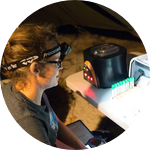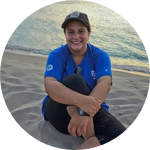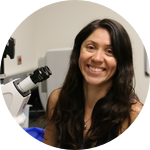About This Project
When a sea turtle hatches, it is impossible to identify their sex because they don’t have any sex-specific external characteristics. They don’t have sex chromosomes, instead their sex is determined by the nest incubation temperature. Recently, our lab has shown that the sex of a hatchling can be determined by the presence of a protein in their blood. Our goal is to improve this assay and develop a large-scale method that will allow us to estimate the sex ratio of a given population.
Ask the Scientists
Join The DiscussionWhat is the context of this research?
Establishing nest sex ratios is key to identifying (and possibly mitigating) the effects of increase of global temperatures on species that rely on temperature to determine their sex (Hulin et al. 2009, Mitchell & Janzen 2010). In sea turtles hot temperatures produces more females and vice versa. Until recently, the techniques used to identify sex in hatchlings required invasive procedures to look at the morphology of the gonads. Our objective is to optimize the protocol previously published (Tezak et al. 2020) that is based on the detection of AMH (Anti Mullerian Hormone) protein and to develop an assay for rapid mass sampling that is cost-effective in comparison. A large-scale sampling is essential to determine sex ratios in a population.
What is the significance of this project?
As temperatures are projected to increase and periods of drought become more extreme under a changing climate, scientists are concerned that a higher proportion of female hatchlings will be produced. (e.g. Jensen et al. 2018). Future populations may not be viable if there are not enough males produced, therefore it is critical that this baseline research be conducted. This proposed method would allow for these studies and thus fill these critical data gaps. The proposed research is part of Gabby Carvajal's dissertation work and addresses multiple goals from the Recovery plan for the Northwest Atlantic Population of the loggerhead sea turtle (Caretta caretta) including to refine and develop techniques for determining sex ratios.
What are the goals of the project?
The technique we are proposing to use may reduce or eliminate logistic barriers to much-needed large-scale sampling.
1. Obtain the loggerhead AMH protein sequence
2. Acquire a custom made antibody specific to the loggerhead AMH protein
3. Create a mass sampling method to determine sex ratios of loggerhead sea turtles
4. Test this technique with other sea turtle species
Budget
The purpose of this project is to optimize the existing protocol and develop a large-scale sexing method. To do this, we need a turtle specific antibody that will allow us to develop a method making it easier, faster, cheaper, and allow for mass sampling to be analyzed with minimum equipment. This budget covers the cost of reagents needed to obtain the sequence of AMH in loggerhead, based on which we will obtain the sequence of the correspondent protein; it also covers the cost of the antibody production which includes the in vitro synthesis of the loggerhead AMH protein, 2 immunizations rounds, the purification of the antibody and shipment to our lab.
Project update: Our updated quote for our project is $5,700 based on an increase cost to antibody production.
Endorsed by
 Project Timeline
Project Timeline
The first step is obtaining the sequence of the loggerhead AMH protein that can be achieve in one month. With the sequence we can order a custom made antibody. The production of the antibody takes 2-3 months according to the company from where we will order it. The optimization of the previous assay to make it a large scale protocol will requiere another 2 months and once we had an established protocol we will be ready to test its applicability in other sea turtle species.
Jul 01, 2021
Project Launched
Oct 01, 2021
Obtain the loggerhead AMH protein sequence
Apr 01, 2022
Acquire the custom made antibody specific to the loggerhead AMH protein
Jun 01, 2022
Establish a large-scale sexing protocol
Jul 01, 2022
Test this protocol in other sea turtles
Meet the Team
Affiliates
Gabriella Carvajal
My name is Gabby Carvajal and i'm a second generation american with a love for the ocean and nature. I enjoy observing nature and asking questions, as to why i'm an aspiring conservation biologist. I'm interested in answering questions that fill data gap needs for endangered species and aid in their conservation by using applied molecular techniques. I am currently enrolled in the Integrative Biology PhD Program at Florida Atlantic University. My research focuses on identifying sea turtle nest sex ratios and developing molecular tools to allow for large-scale studies of nest sex ratios. Sea turtles have temperature dependent sex determination (TSD), with hotter, drier nests producing females and colder, wetter nests producing males. It is important to collect sex ratio information from nesting beaches and to monitor sex ratios as temperatures are expected to increase due to climate change.
Itzel Sifuentes-Romero
My interest in sea turtles started since I was in college where I joined a group of volunteers working in a remote beach in Mexico, country where I was born and raised. Since then, sea turtles have been the primary focus of my research. During my PhD I studied environmental sex determination, trying to unravel the molecular mechanisms through which environmental factors, such as temperature direct the differentiation of the gonads. Later as a postdoctoral fellow at Florida Atlantic University, I studied the effect of moisture conditions during incubation on turtle embryonic development focusing on two main aspects: embryo growth and sex ratio, project in which we develop a non-invasive method to identify sex in hatchlings via blood samples. I have participated in multiple, collaborative research projects that combined expertise from different labs in Mexico, France and the US resulting in 24 peer-reviewed publications. The ultimate goal of this current project is making this technique accessible to any sea turtle group because we recognize the importance on estimating sea turtle sex ratios worldwide.
Additional Information
One of my first experiences working with sea turtles was as a volunteer in a nesting beach in Jalisco, Mexico. Our work there was to relocate all the nests that we encountered to a safer and secure area of the beach where the eggs were protected from predators and poachers. I remember placing the delicate eggs in these new nests that were excavated one next to each other and asking myself if by doing this we were really helping them, at that time little was known about the impact of the temperature on sex determination and sex ratios. Years later, during my PhD, I studied the mechanisms underlying sex determination in turtles and along with other researchers in the same area of study, we started alerting the community that by incubating the eggs in “nurseries”, where all the nests were experiencing the same environmental factors (temperature, humidity, precipitation, etc.) we might have been skewing sex ratios. After my PhD, we started a project in an Olive ridley massive nesting beach in Oaxaca, Mexico, where we were trying to estimate the sex ratio of that population. We conducted this study for 4 consecutive years, and as suspected, due to the increasing temperatures we were experiencing, we found in the last 3 years 70-80% of hatchlings were female. However, this study was based on dead in nest hatchlings, because to identify their sex, we needed to look at the gonads. This work raised a lot of more questions for me: How is it possible to maintain the population with most of the individuals being females?? Was this estimation accurate? How do we know if there is a sex that is more fit to survive? Was it possible that more females were dying trying to reach the ocean than males? This study convinced me that we needed an accurate and non-invasive way to identify the sex of hatchlings. With that in mind, I decided to come to the US and joined the Wyneken Lab at FAU, where they were also studying the effects of climate change on sex ratios but in a different species, the loggerhead sea turtle. Interestingly, their results were like ours, a higher percentage of females over a period of 12 years. So, we decided to actively look for a way to identify the sex of a hatchling in a non-invasive and accurate way. Knowing that there were a set of genes and proteins that were express in a sex specific way in the gonads, we just needed to find one that were present also in the blood. That is how we developed this assay that is based on the detection of AMH (Anti-mullerian hormone), a protein that is present in the blood only in males, this was indeed a great step. When I was thinking of the next steps, I met Gabby and she told me her story:
“Growing up in New York, I would go to the beach with my mom and friends during the summer months and I remember those being the best days. I would dig for sand crabs, swim in the waves, and examine the rack line looking for neat things. I’ve been curious about the natural world since I can remember, starting in elementary school I wanted to be a marine biologist. My mother fostered this curiosity and has always supported my dream to study what I was truly passionate about. In high school, I was able to take a course in the Caribbean learning about marine reserves while also learning to dive. This was my first exposure to conservation, and I knew then I wanted to be a marine conservationist to make a positive impact and be an advocate for the ocean. While I was in college, I was first exposed to sea turtles volunteering in Costa Rica. I had a small red notebook with me where I wrote down research questions I thought of during my time there, with one being “how can you tell if a sea turtle hatchling is a male or female?”. I was thinking there had to be a way but was surprised that there currently was no way unless sacrificing the hatchling. When the study of the sex specific protein in loggerheads was published I geeked out because I knew the importance of such a discovery and wanted to build off this work for my PhD research”
This is how we started building this project, because both of us knew that we needed to improve and expand this assay, to first, make it a more amenable protocol that allow us to analyze a higher number of samples and that works in other sea turtle species. And that’s how Gabby and I started working together. Our ultimately goal is, once we make it a large-scale sexing technique, to make this assay available to any sea turtle project in the world, because we know climate change and global warming is imminent and we need to know what the real sex ratio in our beaches is to come up with solutions to mitigate the effects of this changing climate.
Project Backers
- 54Backers
- 141%Funded
- $5,676Total Donations
- $105.11Average Donation




